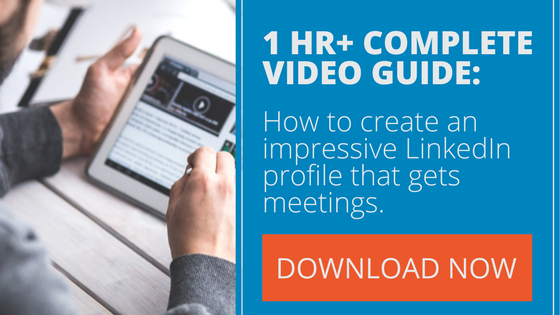LinkedIn job descriptions and accomplishments are going to allow us to really make an impact with the people we connect with on LinkedIn. Because–let’s say that you do everything right and can get folks to your profile–they’re going to want to see that you’ve done something impressive.
*Just so you know, this post comes with a free worksheet to help you go from Setup to Sales Call with LinkedIn. Get the accompanying worksheet here
Once more, let’s start off with the basics that we know about creating a professional LinkedIn business profile before we get into talking job and accomplishments.
So again, you’re probably tired of hearing about now, but here’s our perfect profile formula.
PH + KRD + KRL + MI =Perfect Profile
As we’ve previously discussed:
The “PH” part right stands for your professional headshot, “KRD” is going to be your keyword rich descriptions. “KRL” is going to be your keyword rich lists and “MI” is going to be your media inserts-
Keyword-rich lists and media inserts are the biggest parts of our job and accomplishments section.
This is really where the last two portions of the profile formula are going to shine.
Why else should we focus on these LinkedIn job descriptions and accomplishments? They allow us to cement a positive impression with the people that find us on LinkedIn.
And the people finding us will be our talent trio: our peers, the VIPs that can help us rise and third parties, or weak ties. Job and accomplishments are the standard by which the talent trio judges you.
You may be very nice, very kind, but ultimately folks want to know that you can help them reach their goals. If you’re having a bit of a struggle trying to figure out how to express that, feel free to review the recent keyword research post. Soon, we’ll also cover the VIP or buyer persona.
Tricks To Spruce Up LinkedIn Job Descriptions and Accomplishments
Now, you may not feel you have a big number of impressive jobs and accomplishments. That doesn’t matter as much as you think. Try some of these tips and see if doesn’t improve your professional presence.
First, a few house rules:
Big no-no to avoid #1: Making stuff up.
I know you wouldn’t do this–but I’ll say this just to be clear–this not a chance to lie. Get creative, but let’s keep keep away from outright deception, such as adding qualifications and accomplishments we have not done.
As MSNBC recently reported, “75 percent of human resource managers have caught a resume lie.”
Among the examples they share, is one man who claimed to be a CIA anti-terrorist spy while he would have been in elementary school. Let’s not do that.
Big no-no to avoid #2: Telling people you’re unemployed
You’ve seen it expressed in many ways: “seeking opportunities (who isn’t?),” “unemployed” etc. People will actually place this in their LinkedIn headline to inform the world of their current lapse in vocation.
Please do not ever be “unemployed” on LinkedIn. You have no excuse to be unemployed on LinkedIn. Here is where you get creative.
I know this because I have been out of traditional employment myself. During these times, I kept learning and kept working on projects and businesses with potential. Whether Pajama Jobs USA, or Men’s Home and Workout on my resume, I devoted myself to these efforts and made them my occupation.
While it might seem logical to let others know you’re looking, it doesn’t work that well. Just search out the proof for yourself or read the recently updated Washington Post story “Companies won’t even look at resumes of the long-term unemployed” to learn more.
The same goes for business. I don’t know a single one that isn’t “looking for clients.”
It’s called the base of one factor. I want you to think of that awkward guy or gal who was in class with you in highschool. They seemed desperate to talk and hang (Heck, I’ve experienced this recently). It doesn’t always matter if they were/are great people–desperation is never attractive.
Compare that scenario to the guy or gal who has more friends and connections than they know what to do with. When you have some it’s easier to get more, when you don’t have any (or you advertise that fact) then it’s tough to get one. The rich get richer and the poor get poorer. It’s just another one of those laws of the universe.
I’m not going to keep beating on this topic, but remember, we live in an age of amazing possibilities. You can have an occupation if you want one.
Definition of occupation
1 a : an activity in which one engages. Pursuing pleasure has been his major occupation.
b : the principal business of one’s life : vocation Teaching was her occupation.
Here are some ethical tricks you can use on LinkedIn concerning your work history.
Include important keywords for your niche
Review our post on keyword research if you need help finding your right keywords.
For example, as a marketer, I’m going to repeat some of the same terms in my job descriptions and titles, when appropriate.
You can always add a little pipe at the end of job title and insert a relevant keyword there. It’s a creative way to let people know what your specific positions have in common.
For example, when I write about being a personal finance journalist and a publishing editor, I’ll include a pipe with the phrase “content marketing” for each. This was especially relevant when I was targeting content marketing positions in the past.
Craft and tell your job story
I was actually helping someone out with this the other day. You have to tell a story with your profile. We’re obsessed with stories. Think about this: the hottest must-see movie that’s made millions and billions of dollars is just another souped-up story. It’s our preferred way of accepting information.
People want to see the progression of your story. You don’t have to overthink this. Some tips:
Separate jobs by promotions and seniority-level
It has to make sense. Remember that old business archetype of the mailroom kid eventually becoming the CEO or Chief Executive Officer? How would you explain her climb in levels?
You might show a progression that looked like…
Mailroom associate
Customer Service Representative
Customer Success Manager
Associate Vice President of Service and Operations
Senior Vice President of Service and Operations
Chief Executive Officer (CEO)
If you’ve been working at the same company for a long time, then separate your different levels of positions with their own dates and titles.
If your resume isn’t this straightforward, look into how you might ethically give your titles a nudge to help craft the story you want to tell. We use our LinkedIn profile, especially the LinkedIn job descriptions and accomplishments section, to the tell the story of our rising success.
Include media insertions and keyword-rich lists
This came to me after consistently being asked what I had accomplished at previous positions. Keyword-rich lists allow us to share all of that information in a way harried professionals might still notice without reading our entire profile. No one has that kind of time.
Enter bullet points and images.
For me, I will literally list everything I have done in a certain gig. So I will talk about WordPress, digital marketing strategy, and about 20 different skills that I used. That way if someone searches for a specific skill that I possess, I may at least show up in a search. If people finding you are impressed by what you know–then that’s a bonus.
Now, for media inserts. People are still very visually-driven. Consider how YouTube has grown in size and capacity to be just as important as Google.com’s search bar. I’ll use this to associate myself with well-known outlets and publications.
If you’ve given any recorded talks or speeches, led discussions or done any somewhat impressive thing at any position resulting in some sort of media, a picture, video, etc–then include it with the corresponding position.
Also, when it comes to making your LinkedIn profile stand out, don’t forget to add in your certifications, courses taken, and languages spoken or read.
I encourage you to check out the worksheet that comes along with this post because it’s going to help you think through building your profile.
Stick around for the next post where we will be talking about how to start finding and reaching VIPs and leads.
*Just so you know, this post comes with a free worksheet to help you go from Setup to Sales Call with LinkedIn. Get the accompanying worksheet here










